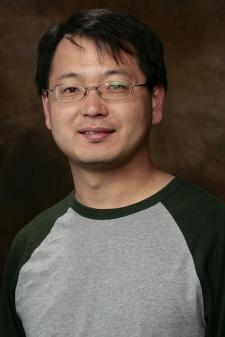Atomic Particles Help Solve Planetary Puzzle
FAYETTEVILLE, Ark. – A University of Arkansas professor and his colleagues have shown that the Earth’s mantle contains the same isotopic signatures from magnesium as meteorites do, suggesting that the planet formed from meteoritic material. This resolves a long-standing debate in the field over the planet’s origins.
Fangzhen Teng, assistant professor of geosciences at the University of Arkansas, and Wei Yang and Hong-Fu Zhang of the Chinese Academy of Sciences report their findings in Earth and Planetary Science Letters.
The researchers examined magnesium isotopes in chondrites – meteorites containing elements formed from the condensation of hot gases in the solar system. They also looked at samples from different depths in the Earth’s mantle. Isotopes have the same chemical properties, but different weights, so some processes cause what looks like the same material to behave differently. The different proportions of isotopes within a rock can tell scientists something about the original source of the material.
Magnesium makes a particularly good marker for planetary origins because, first, isotopes of magnesium can be separated during evaporation and condensation in the solar system and, second and more uniquely, one isotope of magnesium, Mg26, is a decay product of Al26, which existed in the early solar system for less than 5 million years. Thus, materials with different origins and ages contain different amounts of Al26, which results in different amounts of magnesium isotope.
“Isotopes are very sensitive to sources of material,” Teng said. “We can use isotopes as a tool to further understand planetary origins.”
Teng’s group analyzed different types of rocks from different depths of the Earth’s mantle from a site in North China and compared the results to those of samples from chondritic meteorites. They looked at magnesium isotopes in samples from the whole rock, but they also separated out minerals from the rocks and examined the magnesium isotope composition of these minerals as well.
“The samples from Earth were slightly different from one another,” Teng said. Their compositions also matched closely with those of the meteorites, the researchers report.
“That’s very strong evidence that Earth has a chondritic magnesium composition,” Teng said.
Teng is a professor in the J. William Fulbright College of Arts and Sciences and is a member of the Arkansas Center for Space and Planetary Sciences.
Teng’s research is funded by the National Science Foundation.
Contacts
Fangzhen Teng, assistant professor, geosciences
J. William Fulbright Colleges of Arts and Sciences
479-575-4524,
fteng@uark.edu
Melissa Blouin, director of science and research communication
University Relations
479-575-3033,
blouin@uark.edu
Headlines
Affairs of the Heart
Find out how biomedical engineering professor Morten Jensen is developing innovative devices to produce better outcomes in cardiovascular medicine.
Students, Faculty and Alumni Kick Off Centennial Year of School of Law
Founded April 14, 1924, the School of Law faculty, students and alumni started the celebration of its centennial year with a Founders Day event and will continue with more commemorative events this coming fall.
Yearly Academic Award Winners, Ambassadors Recognized by Bumpers College
Schyler Angell, Lexi Dilbeck, Cason Frisby, Tanner Austin King, Anna Brooke Mathis, Carrie Ortel, Lucy Scholma, Kadence Trosper and student ambassadors were honored at the college's annual reception.
World Premiere of 'Cries from the Cotton Field' Slated for May 8
Cries from the Cotton Field chronicles the journey of 19th century Italian immigrants from northern Italy to the Arkansas Delta and ultimately to Tontitown. It will premier at 6 p.m. May 8 in Springdale Har-Ber High School.
Fay Jones School's Earth Day Event Spotlights Sustainable Materials and Projects
"One day doesn't seem like a lot, but one day can empower individuals and groups, energize them to work for change and innovate for transformative solutions," professor Jennifer Webb said of the students' design work.





